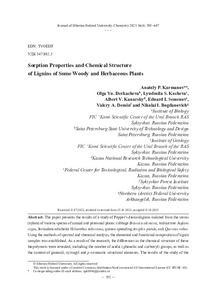Сорбционные свойства и химическая структура лигнинов некоторых древесных и травянистых растений
Автор:
Карманов, А. П.
Деркачева, О. Ю.
Кочева, Л. С.
Канарский, А. В.
Семенов, Э. И.
Демин, В. А.
Богданович, Н. И.
Karmanov, Anatoly P.
Derkacheva, Olga Yu.
Kocheva, Lyudmila S.
Kanarsky, Albert V.
Semenov, Eduard I.
Demin, Valery A.
Bogdanovich, Nikolai I.
Дата:
2023-12Журнал:
Журнал сибирского федерального университета. 2023 16(4). Journal of Siberian Federal University.Chemistry 2023 16(4)Аннотация:
В работе представлены результаты исследования диоксанлигнинов Пеппера,
выделенных из стеблей (ксилемы) различных видов однолетних и многолетних растений: капусты
Brássica olerácea, орехового дерева Juglans regia, топинамбура Helianthus tuberosus, лебеды
раскидистой Atriplex patula, дуба Quercus robur. С помощью методов спектрального и химического
анализа установлен элементный и функциональный состав образцов лигнина. В результате
исследований выявлены различия в химической структуре этих биополимеров, в том числе
по количеству кислых (фенольных и карбоксильных) групп, а также содержанию гваяцильных,
сирингильных и п-кумаровых структурных элементов. Представлены результаты исследования
поверхностно-пористой структуры лигнинов методом низкотемпературной адсорбции азота.
Выполнена оценка адсорбционной способности исследуемых препаратов в отношении одного
из наиболее опасных микотоксинов – афлатоксина В1. Эксперименты проведены в водных средах,
имитирующих условия в желудочно-кишечном тракте млекопитающих. Установлена взаимосвязь
между параметрами поверхностно-пористой структуры, химическим строением и показателями
адсорбции–десорбции. Полученные результаты свидетельствуют о том, что наиболее важная роль
для осуществления прочной адсорбции афлатоксина В1 принадлежит механизму хемосорбции,
обусловленному присутствием кислых функциональных групп лигнинов The paper presents the results of a study of Pepper’s dioxanlignins isolated from the stems
(xylem) of various species of annual and perennial plants: cabbage Brássica olerácea, walnut tree Juglans
regia, Jerusalem artichoke Helianthus tuberosus, quinoa spreading Atriplex patula, oak Quercus robur.
Using the methods of spectral and chemical analysis, the elemental and functional composition of lignin
samples was established. As a result of the research, the differences in the chemical structure of these
biopolymers were revealed, including the number of acidic (phenolic and carboxyl) groups, as well as
the content of guaiacil, syringyl and p-coumaric structural elements. The results of the study of the surface-porous structure of lignins by the method of low-temperature adsorption of nitrogen are presented.
The adsorption capacity of the studied drugs for one of the most dangerous mycotoxins, aflatoxin B 1,
was assessed. The experiments were carried out in aquatic environments that mimic conditions in
the gastrointestinal tract of mammals. The relationship between the parameters of the surface-porous
structure, chemical structure and adsorption-desorption indicators has been established. The obtained
results indicate that the most important role for the implementation of strong adsorption of aflatoxin B 1
belongs to the mechanism of chemisorption, due to the presence of acidic functional groups of lignins

